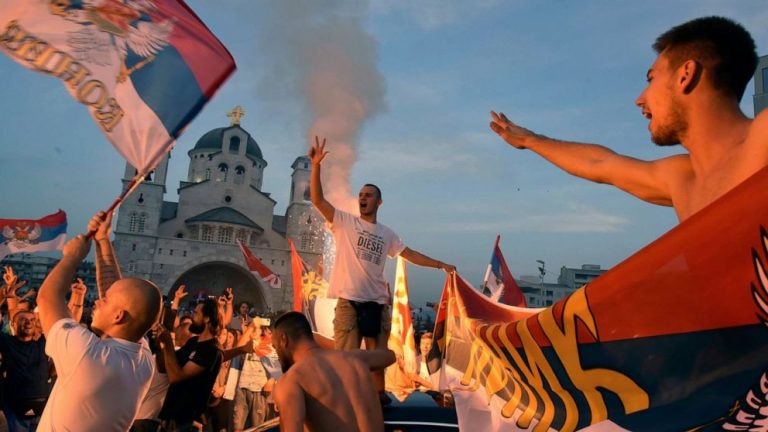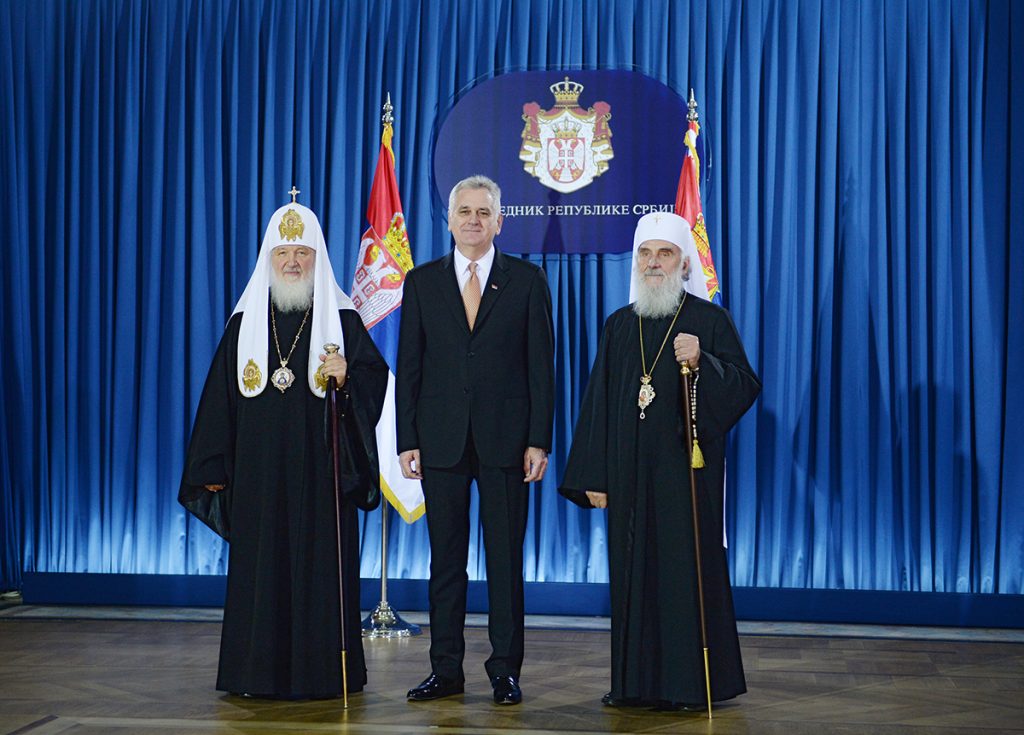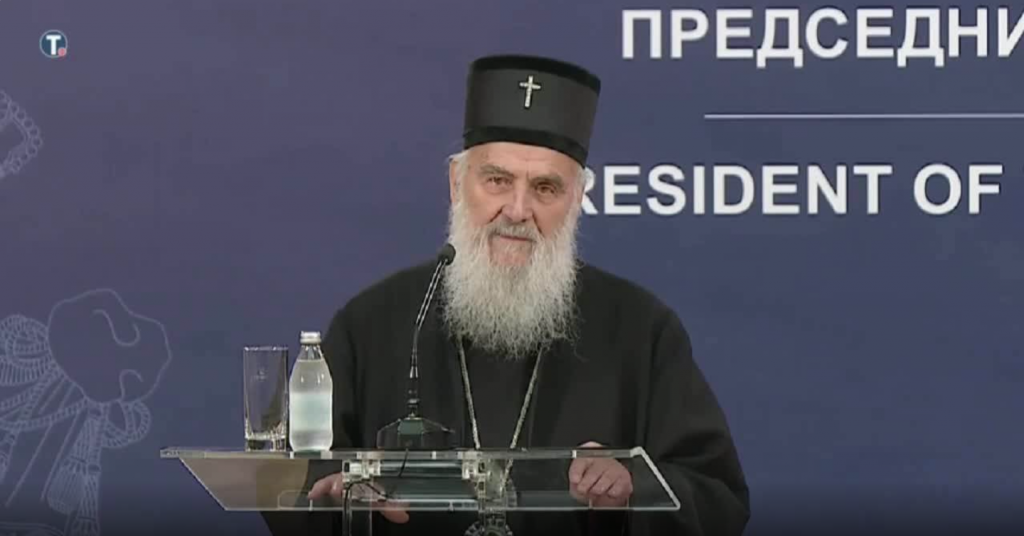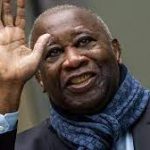On almost all significant occasions in Kosovo, Serbian Orthodox Church (SOC) attempts to do something that asks for trouble in Kosovo. Not only that they have never spoken about their role in the bloody wars in former Yugoslavia inciting hate and violence, but the SOC to this date continues similar narrative cultivation that serves Milosevic agenda.
On the 22 anniversary of NATO Agreement to end bombing of Yugoslavia and withdrawal of Yugoslav forces from Kosovo, SOC organized a liturgy where they also called Kosovo a Serbian holy land. What is significant, they labeled this liturgy as the first one after the war which was bought by many opinion makers and officials in Serbia and some in Kosovo too. The church where the liturgy took place is located at the University campus in Prishtina and was built during the 90s under the auspices of Milosevic. This particular church is of significant importance in the symbolization of Albanian struggle. As the church’s foundation was laid by a infamous mob and war criminal Zelko Raznjatovic Arkan, who’s units committed atrocities in Bosnia and Kosovo- he is an inspiration for Serbian foreign fighters in Ukraine and elsewhere as well. After the fall of Milosevic, Arkan was assassinated in Belgrade.
The SOC chooses particular days to incite reactions from the Kosovar public so it legitimizes their narrative of struggle and attacks from the Kosovars. On a Youtube Video of a protest in Belgrade, many sounded almost disappointed that there were no attacks on the clergymen at the church. That the SOC is involved in military-political issues is also confirmed in a book by Serbian author Milorad Tomaniq “Serbian Church at War and the Wars within It”. “The bishops of the Serbian Orthodox Church attached more importance to strategic, military-political issues than to theological issues”, (page 159), the author writes.
As it is not accidental the construction of building called Church on the University Campus, nor is the date chosen by the Serbian Orthodox Church to hold a liturgy 23 years after its construction says Blerim Latifi, a professor of political philosophy and philosophy of religion at the University of Prishtina, “June 10 is the establishment date of the League of Prizren, the first Albanian national organization, June 10 is the date is the beginning of Serbian military and police departure from Kosovo after the signing of their defeat in Kumanovo on June 9, 1999, June 10, 2007 during his visit to Tirana, the US President Bush, announced to the world that Kosovo’s Independence is a done deal. And, holding a liturgy in the heart of Prishtina, in a church whose cornerstone was laid by the criminal Arkan himself, the Serbian Orthodox Church wanted and managed to convey a political message against these three dates”, Latifi considers.
From the past experiences with the Deçani Monastery, we know that the latter, by decision of the Constitutional Court, has owned 24 hectares of public property around the Monastery, as the property of Church, this happened because the Church allegedly felt endangered by the movement of people in an area nearby. Local authorities claim that the property belongs to socially-owned enterprises and that it never belonged to the Monastery, claiming that the Constitutional Court has legalized the decision of Slobodan Milosevic, of 1997, when he decided to donate that property to the monastery.
The Serbian Orthodox Church has for centuries worked with Serbian nationalistic chauvinism. Even during the war in Bosnia and Herzegovina SOC did the same. It went to even build churches on the private properties of bosniaks. Bosnian authorities on Saturday demolished a Serbian Orthodox church that was illegally built on land owned by a Bosniak woman, a move that comes after a 20-year legal battle that saw the case reach the European Court of Human Rights. The United States Embassy in B&H showed gratitude to Fata Orlovic for her ongoing fight for justice in the exercise of her property rights. Orlovic’s husband was among the 8,000 Bosnian people killed by Serbian forces in Srebrenica in 1995. The Srebrenica massacre has been internationally recognized as Europe’s only genocide since World War II.
The Serbian army used religious symbols alongside nationalist ones in Kosovo war as well. There have been many cases where the Serbian army has used sharp tools to draw the orthodox cross on the body and face of people who were massacred and raped during the war in Kosovo. They did the same in homes and other objects. Similarly, graphittis of the cross with 4 C appeared throughout burned houses and demolished property too.
Only last year, SOC organized protests in Montenegro as well, under the pretext of rights like other religious communities. Disputes between the former Montenegrin government and the Serbian Orthodox Church escalated in December 2019, when tens of thousands of Serbian Orthodox priests and monks, believers and supporters began months of nationwide protests demanding the withdrawal of the controversial Freedom of Religion Act, which they said allowed the confiscation of Church property. Under the new law, religious groups that cannot provide proof of ownership risk having their lands and buildings seized from the state.
Shortly after the new government headed by Zdravko Krivokapic was elected, it amended the controversial law in line with the interests and demands of the Serbian Orthodox Church. The basic agreement the state announced it will be signed by Serbian Orthodox Church, which regulates the rights and obligations between the state and the church, has not been signed yet.
The Serbian Orthodox Church, as an offshoot of Belgrade’s policy in the Balkans, is seeking full autonomy over its properties, while Serbia, as a satellite state of Russia in the Balkans, is trying to create chaos through religion in order to extend its influence in the region. Given that the Kosovo-Serbia talks are on the verge of resumption, provocations have been increased in the direction of Kosovo. The Kosovo Police and consequently the Government were not notified about the liturgy held on June 10. Knowing the construction history of this building and its illegality, this clearly shows the Serbia Government’s interest to cause riots before the Kosovo-Serbia talks and legitimize its demand for exterritoriality of the SOC in Kosovo. Such attempts by Serbia are dangerous and could provoke conflict by inciting hate narratives and propaganda.







